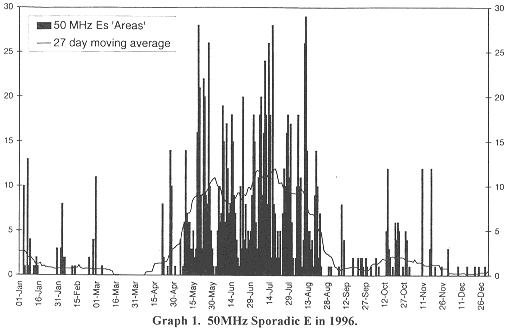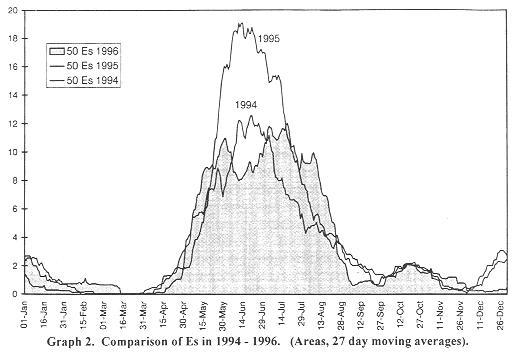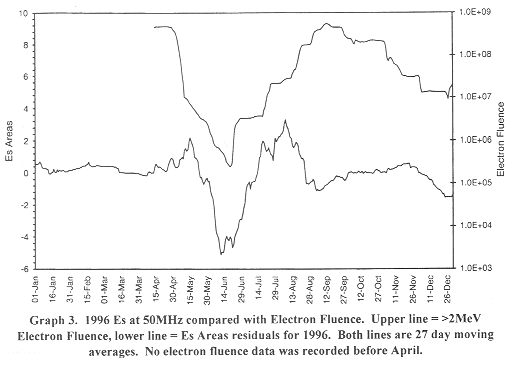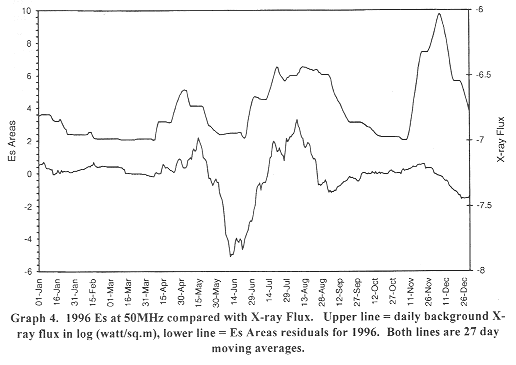Issue 53 Six News, May 1997
by Steve Reed, G0AEV
Adapted from the "Six and Ten Report", January 1997
There has been much debate about the quality and quantity of Sporadic E (Es) experienced in the UK in 1996. Most would probably agree that Es was poor at high frequencies and for short skip but reasonably good at lower frequencies and for long haul (multi-hop) propagation. Conditions were relatively very poor in June and December, somewhat better than ‘normal’ at some other times. How individuals rated the year overall varied very considerably. 144 MHz operators and those who were relying on June propagation for DX contacts were disappointed, others were pleasantly surprised to find 50 MHz openings (including trans-Atlantic) outside of the expected norms. Whatever your opinion, the distribution of Es in 1996 was clearly unusual. The purpose of this article is to quantify this distribution and see if the season’s unusual features help identify relationships with, and causes of, sporadic E .
 The Six and Ten Reporting
Club, a group of amateurs interested in propagation at
frequencies at around the VHF-HF boundary, collects and collates
data from a dedicated group of operators: this material is
analysed and discussed in the monthly Six and Ten Report. Es
activity at 50 MHz is measured in the Reports using an
‘areas’ variable based on ‘countries’
heard/worked from the UK. The daily areas count provides the raw
data for the work presented here. High values of the
‘areas’ variable mean geographically widespread events,
but not necessarily short skip, high MUF or long-lived events.
Graph 1 shows the daily 50 MHz areas numbers for the year, plus a
27 day moving average of the same data (this used to smooth short
term variance and remove any effects related to solar rotation).
The graph shows features common to any year - a major Es season
in the summer, and a minor season in mid-winter (which was good
in January, but poorly defined in December 1996). A common
feature, but one that is not always recognised, is a small
autumnal event that has no counterpart in the Spring. The graph
shows that May and August had some of the best days for Es of the
year. Note also the several isolated (and unusually strong) Es
events in February and November.
The Six and Ten Reporting
Club, a group of amateurs interested in propagation at
frequencies at around the VHF-HF boundary, collects and collates
data from a dedicated group of operators: this material is
analysed and discussed in the monthly Six and Ten Report. Es
activity at 50 MHz is measured in the Reports using an
‘areas’ variable based on ‘countries’
heard/worked from the UK. The daily areas count provides the raw
data for the work presented here. High values of the
‘areas’ variable mean geographically widespread events,
but not necessarily short skip, high MUF or long-lived events.
Graph 1 shows the daily 50 MHz areas numbers for the year, plus a
27 day moving average of the same data (this used to smooth short
term variance and remove any effects related to solar rotation).
The graph shows features common to any year - a major Es season
in the summer, and a minor season in mid-winter (which was good
in January, but poorly defined in December 1996). A common
feature, but one that is not always recognised, is a small
autumnal event that has no counterpart in the Spring. The graph
shows that May and August had some of the best days for Es of the
year. Note also the several isolated (and unusually strong) Es
events in February and November.
 Graph 2 shows the 1996 season
represented by the ‘areas’ 27 day averages compared
with equivalent data from 1995 and 1994. The gross distributions
for the three years are similar, but while 1994 and 1995 both had
"classic" bell-shaped summer Es distributions, 1996 has
a "decapitated" summer distribution. Note the broader
flanks to the summer 1996 distribution indicating better April
and August Es than in the previous 2 years, the notable dip in
June corresponding to the poor mid-summer conditions, and the
almost complete absence of winter Es in December. 1995 was
clearly much the best of the last three years, though one should
be careful of interpreting absolute values because of the way the
data is calculated from an imprecise countries score. Although
the 1996 distribution is strange, the amount of Es present at 50
MHz over the year was very similar to that in 1994.
Graph 2 shows the 1996 season
represented by the ‘areas’ 27 day averages compared
with equivalent data from 1995 and 1994. The gross distributions
for the three years are similar, but while 1994 and 1995 both had
"classic" bell-shaped summer Es distributions, 1996 has
a "decapitated" summer distribution. Note the broader
flanks to the summer 1996 distribution indicating better April
and August Es than in the previous 2 years, the notable dip in
June corresponding to the poor mid-summer conditions, and the
almost complete absence of winter Es in December. 1995 was
clearly much the best of the last three years, though one should
be careful of interpreting absolute values because of the way the
data is calculated from an imprecise countries score. Although
the 1996 distribution is strange, the amount of Es present at 50
MHz over the year was very similar to that in 1994.
 Can we explain the unusual
distribution of Es in 1996? The presentation in graph 2 is not
very helpful because the overall distributions are dominated by
seasonal trends. To identify the true relative differences
between the 1996 distribution and those of previous years,
residual values have been calculated - these are the simple
difference between the 1996 Es areas 27 day moving average and a
three year mean (moving average) value. Negative residual values
indicate conditions poorer than average, positive better than
average. Note that the data are most reliable for the summer
months. The 1996 residual line is plotted in graphs 3 and 4 and
shows clear negatives in June and December (indicating much
poorer than average) but positives for April-May and July-August
(better than average). This broadly agrees with the opinions of
50 MHz operators.
Can we explain the unusual
distribution of Es in 1996? The presentation in graph 2 is not
very helpful because the overall distributions are dominated by
seasonal trends. To identify the true relative differences
between the 1996 distribution and those of previous years,
residual values have been calculated - these are the simple
difference between the 1996 Es areas 27 day moving average and a
three year mean (moving average) value. Negative residual values
indicate conditions poorer than average, positive better than
average. Note that the data are most reliable for the summer
months. The 1996 residual line is plotted in graphs 3 and 4 and
shows clear negatives in June and December (indicating much
poorer than average) but positives for April-May and July-August
(better than average). This broadly agrees with the opinions of
50 MHz operators.
 Why were June and December so
poor, and the other months relatively good? Graphs 3 and 4 show
greater than 2 MeV electron fluence data and background X-ray
flux, both as 27 day moving averages, plotted with the 1996 Es
residual line. The large peak in X-ray flux in late November
represents the position of several X-ray flares (largest of
M1.0).
Why were June and December so
poor, and the other months relatively good? Graphs 3 and 4 show
greater than 2 MeV electron fluence data and background X-ray
flux, both as 27 day moving averages, plotted with the 1996 Es
residual line. The large peak in X-ray flux in late November
represents the position of several X-ray flares (largest of
M1.0).
The visual correlation between the Es and electron/X-ray flux speaks for itself. The June ‘minimum’ appears related to a combination of low electron counts and low solar X-ray emissions. How significant or otherwise these data may be is open for discussion, but variance in both X-ray flux and electron fluence have been used in previous studies to explain Es distributions. For example, Ray Cracknell, G2AHU (Six and Ten Report, October 1994), discussed the anti-correlation of electron fluences with solar activity over a solar cycle, and the potential positive correlation with Es. More recently Geoff Brown, GJ4ICD, pointed out apparent correlations of discrete X-ray flux peaks with Es events. Factors such as 2800 MHz solar flux, Ap index and proton fluence data show no obvious correlations with the 1996 residuals data. More work is needed to pin down the relationships that appear to exist, but at the very least the data presented here help indicate new avenues for research into the causes of Sporadic E. A small consolation, perhaps, for those who thought poorly of the propagation that 1996 had to offer.
![]() To return to the archive page click here
To return to the archive page click here